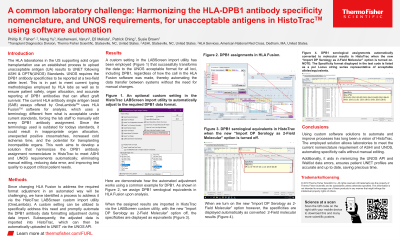Back

A common laboratory challenge: Harmonizing the HLA DPB1 antibody specificity nomenclature, and UNOS requirements, for unacceptable antigens in HistoTrac using software automation.
(P119) A common laboratory challenge
Location: Platinum Ballroom

Poster Presenter(s)
Aim: The HLA laboratories in the US supporting solid organ transplantation use an established process to upload unacceptable antigen (UA) results to UNET. UNET requires the DPB1 antibody specificities to be reported at a two-field allele level. The current HLA antibody single antigen bead (SAB) assays offered by OneLambda uses HLA Fusion software for analysis, which uses a terminology different from what is ASHI-approved or UNOS-accepted, forcing the lab staff to manually edit every DPB1 antibody assignment. This work aims to develop a solution that harmonizes the DPB1 antibody assignment nomenclature in HistoTrac to meet ASHI and UNOS requirements automatically, eliminating manual editing, reducing data error, and improving test quality to support critical patient needs.
Method: Since changing HLA Fusion to address the required format adjustment in an automated way will be challenging, we have identified a process to address it via the HistoTrac LABScreen custom import utility (OneLambda). A custom setting can be utilized to specifically address this need and promptly automate the DPB1 antibody data formatting adjustment during data import. Subsequently, the adjusted data is imported into HistoTrac, which can then be automatically uploaded to UNET via the UNOS API.
Results: A custom setting in the LABScreen import utility has been employed that successfully transforms the data to the UNOS acceptable format for all loci, including DPB1, regardless of how call in the HLA Fusion software was made, thereby automating the data transfer between systems without the need for manual changes.
Conclusion: Using custom software solutions to automate and improve processes has long been a vision of HistoTrac. The employed solution allows laboratories to meet the current nomenclature requirement of ASHI and UNOS, automating specificity calls without manual editing. Additionally, it aids in minimizing the UNOS API and Waitlist data errors, ensures patient UNET profiles are accurate and up to date and saves time.
Method: Since changing HLA Fusion to address the required format adjustment in an automated way will be challenging, we have identified a process to address it via the HistoTrac LABScreen custom import utility (OneLambda). A custom setting can be utilized to specifically address this need and promptly automate the DPB1 antibody data formatting adjustment during data import. Subsequently, the adjusted data is imported into HistoTrac, which can then be automatically uploaded to UNET via the UNOS API.
Results: A custom setting in the LABScreen import utility has been employed that successfully transforms the data to the UNOS acceptable format for all loci, including DPB1, regardless of how call in the HLA Fusion software was made, thereby automating the data transfer between systems without the need for manual changes.
Conclusion: Using custom software solutions to automate and improve processes has long been a vision of HistoTrac. The employed solution allows laboratories to meet the current nomenclature requirement of ASHI and UNOS, automating specificity calls without manual editing. Additionally, it aids in minimizing the UNOS API and Waitlist data errors, ensures patient UNET profiles are accurate and up to date and saves time.

